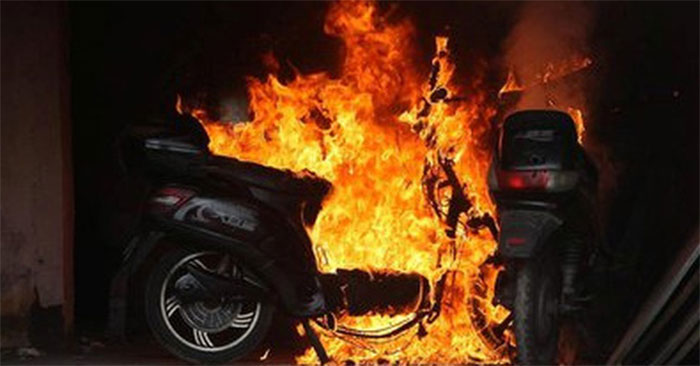
It is highly improbable for a motorbike that fails to start to spontaneously burn out. However, it is important to acknowledge that in certain exceptional cases, a vehicle that is stationary and has not been turned on can still potentially catch fire as a result of a short circuit originating from the battery.
In general, the battery wires of a vehicle (positive and negative) are typically kept separate and well-insulated. However, if these two poles accidentally make contact with each other without going through an electrical consumer, known as a short circuit, it can lead to a fire.

For instance, if the positive wire cover is torn during repair and not properly connected, if it is bitten by rats, or if it degrades over time, there is a risk that the power source may come into contact with the vehicle frame. This can cause the wire cover to heat up and eventually burn. However, it takes a significant amount of time for the fire to spread from the wire to other parts of the vehicle. Therefore, prompt detection and proper handling of such issues can help avoid major consequences.
Motorbike manufacturers take into account the aforementioned incidents and risks when making their calculations, and they have implemented a mechanism to mitigate these risks. Specifically, they have designed a highly sensitive fuse panel that is capable of detecting even minor fires. In the event of a short circuit, the fuse will be blown, preventing the spread of the electrical issue to other areas of the motorbike. Therefore, if there is any spark, it will be confined to the wire area near the battery, minimizing the potential for further damage.
However, if the car receives repairs from an unreliable shop and has an incorrect type of fuse installed or a malfunctioning fuse, it can lead to issues. For example, when a short circuit occurs, the fuse wire does not break as it is supposed to, allowing the short circuit to spread beyond the battery to other areas of the car.
A potential cause for a severe vehicle fire is the leakage of gasoline vapor, which can ignite if there is a short circuit in the electrical wire. Nowadays, most vehicles employ electronic fuel injection, significantly reducing the likelihood of this issue. However, in older cars equipped with carburetors, especially when recently driven, the components remain hot, allowing gasoline vapor to escape easily and potentially leading to a rapid fire outbreak.
Furthermore, the vehicle’s failure can also be attributed to modifications, the inclusion of non-compliant equipment, improper wrapping of electrical wires, and utilization of battery power while the vehicle is parked. These factors can potentially lead to a spontaneous fire outbreak.
Experts recommend that vehicle owners should regularly seek maintenance services from authorized dealerships or well-established stores. It is advised to avoid excessive patching and instead opt for replacement of electrical components to minimize the risk of a potential short circuit. However, it should be noted that this task can be quite challenging.
Furthermore, after a lengthy drive, it is advisable to refrain from immediately parking the car in an enclosed area. Instead, it is recommended to switch off the engine, allow the vehicle to cool down for a few minutes, and then proceed with pushing the car into the designated parking spot.
It is important for users to be cautious and avoid parking their motorbikes in close proximity to flammable materials, as well as near power sources in residential areas, apartments, or parking lots.


